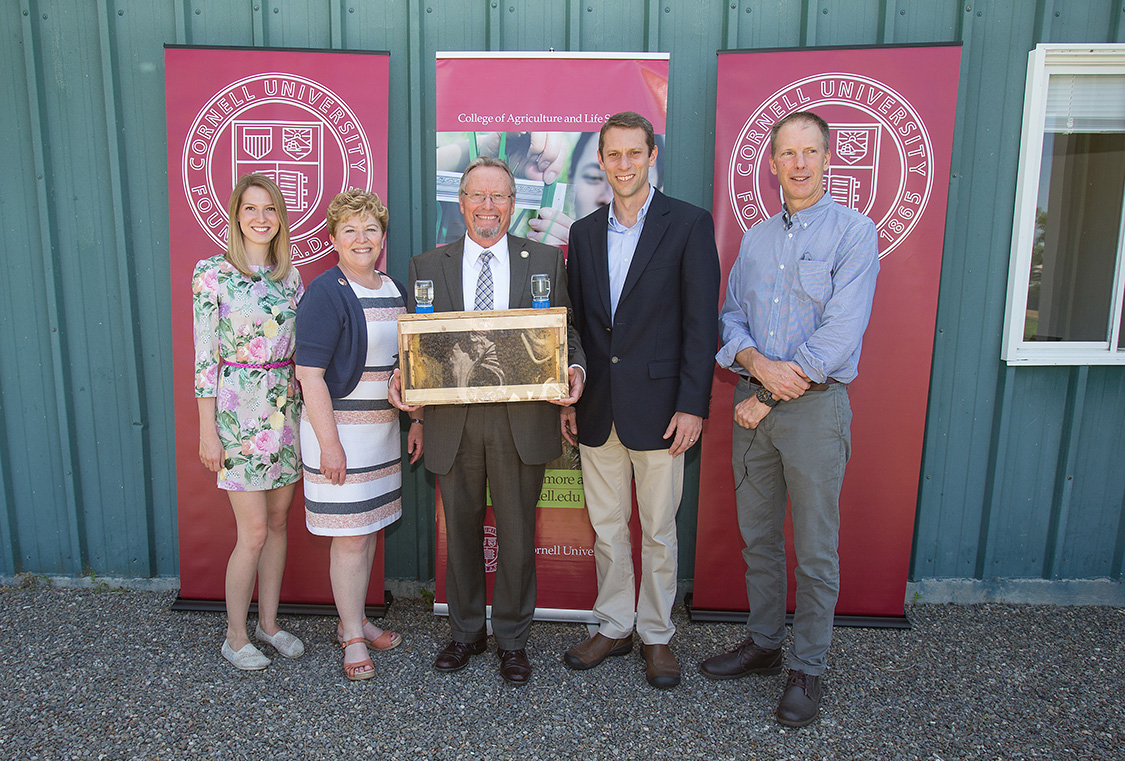New state pollinator protection plan announced at Cornell
By Krishna Ramanujan

State officials and Kathryn Boor, the Ronald P. Lynch Dean of Cornell’s College of the Agriculture and Life Sciences, announced recommendations of the New York State Pollinator Task Force at Cornell’s Dyce Lab for Honey Bee Studies in Varna, New York, June 24.
The 2016-17 state budget includes $500,000 to help implement practices and conduct research outlined in a New York State Pollinator Protection Plan developed by the task force and its advisers.
“Pollinators are critical to food production worldwide, and as a consequence they contribute in a very important way to our state’s, our national and our global economies,” Boor said. “Apples, squash, pumpkins, pears, tomatoes, strawberries, cherries all are among the pollinator-dependent crops that annually generate more than $500 million for New York state’s agricultural economy.”
At the same time, according to research, managed honeybees and native pollinators are in serious decline.
The task force was created in 2015 when New York Gov. Andrew Cuomo directed the commissioners of the New York State Department of Agriculture and Markets (NYSDAM) and the Department of Environmental Conservation to meet with farmers, Cornell researchers and key industry leaders to develop a roadmap to conserve and grow pollinator populations across the state.

The interagency task force coordinated with an advisory group that included farmers, beekeepers and bee experts, pesticide applicators and environmentalists. The working group held four roundtable meetings and solicited public comments before developing the New York State Pollinator Protection Plan.
Richard Ball, commissioner of NYSDAM, announced the task force recommendations, which focus on four areas:
- Development of best management practices for all pollinator stakeholders, including beekeepers, growers, land owners, state agencies and the public;
- Habitat enhancement efforts to protect and revive populations of native and managed pollinators;
- Research and monitoring of pollinators to better understand, prevent and recover from pollinator losses; and
- Development of an outreach and public education program on the importance of pollinators, engaging the public to be active participants to seek solutions to pollinator declines.
“As part of the state budget this year, we were able to increase the Environmental Protection Fund budget to $300 million, and provide $500,000 to pollinator protection,” said State Sen. Tom O’Mara, a Republican from Elmira and chairman of the Senate Environmental Conservation Committee.
Of the $500,000 dedicated to pollinator protection, $300,000 is allocated for research on managed and wild pollinators. Some of those funds will go to two research projects led by research scientist Scott McArt and extension associate Emma Mullen, both in the Department of Entomology.
One study will investigate the effects of pesticides, pathogens and parasites on New York’s wild pollinators; the second project will investigate those effects among hobby and commercial bee operations, in addition to best management practices. This second project will tie in with the establishment of New York’s Tech Team for Beekeepers, led by NYSDAM and supported by $150,000 from the Pollinator Protection Fund. The Tech Team – staffed by Mullen, Paul Cappy (a NYSDAM apiculturist) and agriculture and bee experts – will provide participating apiaries with site-specific technical support.
Also in 2016-17, $1 million from the Environmental Protection Fund will be dedicated to the Cornell/New York State Integrated Pest Management (IPM) program, doubling its budget from last year. This state funding “will help us have an input on issues that include pollinators but go beyond pollinators to controlling pests in ways that will have a minimal impact on the planet,” Boor said.

The pollinator protection plan is important because research indicates New York beekeepers experienced losses to 54 percent of their colonies in 2014 alone. Of the 416 bee species in New York, 13 percent are in decline, due to disease, nutrient deficiencies, habitat loss/fragmentation, poor management practices, lack of genetic diversity and pesticide exposure.
“It’s not just one thing; there are a lot of things that are working against us,” said Ball, who co-chaired the pollinator task force with Kenneth Lynch, executive deputy commissioner of the Department of Environmental Conservation, who spoke at the event.
Ron Rausch, director of the Environmental Management Bureau of the New York State Office of Parks, Recreation and Historic Preservation, also spoke at the event as did Bill Magee, CALS ’61, chairman of the Agriculture Committee in the New York State Assembly. Barbara Lifton, assemblywoman from the 125th District and a member of the Assembly Environmental Conservation Committee, was also in attendance.
McArt, Mullen, Bryan Danforth, professor of entomology, and Jennifer Grant, director of the IPM program, participated in working groups to inform the state’s pollinator plan.
Media Contact
Get Cornell news delivered right to your inbox.
Subscribe